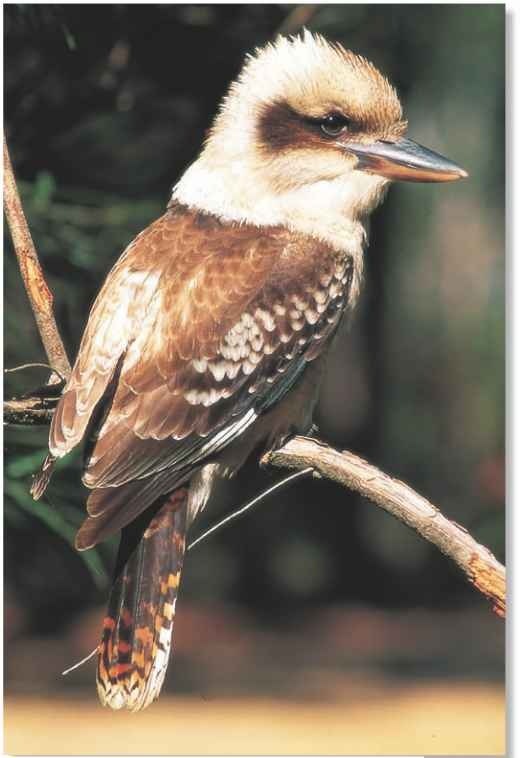ORDER
Coraciiformes
FAMILY
Alcedinidae
GENUS & SPECIES
key features
• An opportunistic predator of Australia’s bush, this crow-sized
kingfisher grabs and stabs prey with its bill
• Master reptile killer that thrashes snakes and lizards to death, often after dropping them from high in the air to stun them first
• Extremely noisy, with a vocabulary of loud calls that sound like chuckles and sidesplitting laughs
where in the world?
Over much of eastern Australia in a broad band (Queensland in j the north to Victoria : and southwestern South Australia); introduced to a corner of western Australia and Tasmania
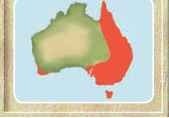
Lifecycle
A startling array of humanlike “laughs” have contributed to the celebrity of the laughing kookaburra, one of the most conspicuous and charismatic Australian birds.
HABITAT
The kookaburra is found in some of eastern Australia’s most arid habitats, especially dry, open eucalyptus forests, but it prefers to be close to a water source. It also occurs in lightly wooded farmland and vast expanses of scrub (the “bush”). It has also adapted well to urban environments and is common in parks and gardens, which it visits to raid bird tables. Living in a sun-drenched climate, the kookaburra needs the shade offered by trees while waiting patiently to swoop on prey.
High profile High perches, especially those close to open spaces, attract kookaburras.
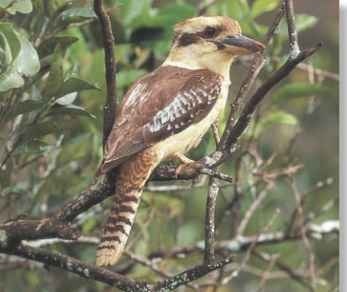
Although not especially skilled at fishing, the laughing kookaburra often snatches fish from shallow ornamental garden ponds.
The laughing kookaburra is nearly 10 times heavier than the Eurasian kingfisher and 50 times heavier than the African dwarf kingfisher.
FOOD & HUNTING
Although it’s a kingfisher, the kookaburra doesn’t hunt over water for fish. But its hunting method is similar to other kingfishers’. It mounts an ambush by watching and waiting from a high vantage point and then, when it spots movement on the ground below, dives down to grab prey in its strong bill. Frequently, it launches its attacks from a perch in a tree, although it also makes use of powerlines, especially in built-up areas.
Australia has a large and abundant range of reptiles, especially snakes; these make up a significant part of the kookaburra’s diet.
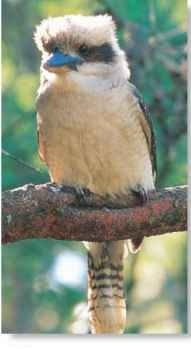
Conservation
The laughing kookaburra is common throughout its range, thriving in towns, cities and natural habitats. Recent estimates based on the density of territories (number of breeding pairs per given area) in a sample of habitats suggest that its population is in excess of 60 million birds. This kookaburra isn’t facing any serious threats and, indeed, receives protection under the same Australian law that forbids the trade of all wild animals.
BREEDING
Holes in tree trunks or cavities in dead and rotten wood make ideal kookaburra nest sites. It also takes over vacant nests of tree termites or occupies holes in the walls of buildings. After mating, the female lays two or three white eggs on the bare floor of the nest chamber.
The male and female pair for life and cooperate to rear their brood. They also receive assistance from nonbreeding “helpers” — offspring from a previous year that haven’t yet found mates. Helpers may assist for up to four years before attempting to breed themselves, participating in most activities associated with nesting, such as incubating, feeding the young and defending the territory. The young fledge after six weeks, but remain entirely dependent on their parents and helpers for another two months.
A STUNNING PERFORMANCE

Swoop to kill…
Scanning the ground from a tree at the edge of a clearing, a kookaburra spots a snake. It silently launches an attack.
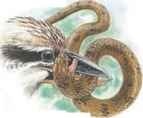
Snake bite…
Striking quickly, it seizes the snake in its bill and shakes it violently.
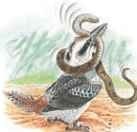
Backbreaking work…
The kookaburra thrashes it against the hard earth.While the snake is stunned, the kookaburra repeats its shaking, breaking the snake’s back.

Down in one
Returning to its favorite perch with the dead snake, the kookaburra swallows it whole without fear of injury.
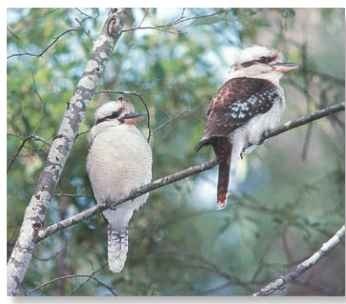
A Sticking together
The kookaburra pairs for life, and both birds share the tasks of maintaining their territory and caring for the eggs and chicks.
BEHAVIOR
Named after its most famous call, the laughing kookaburra is especially vocal in early morning and after sundown.The “laugh” itself lasts for ten seconds, beginning and ending with a series of deep chuckles. In between is the loud, remarkably humanlike sound.
When calling from a perch, the laughing kookaburra adopts a characteristic posture, with its tail cocked and bill pointing upward.
Having a laugh
The kookaburra makes its range of raucous or throaty calls year-round to advertise territory ownership.
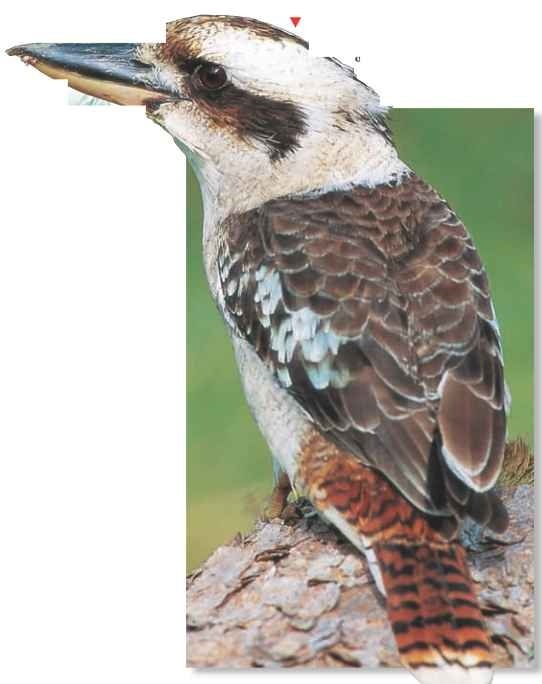
PROFILE
Laughing Kookaburra
A true giant among kingfishers, the laughing kookaburra’s stocky frame and sturdy bill enable it to tackle sizeable, often dangerous prey.

Creature comparisons
In parts of eastern Australia, the blue-winged kookaburra (Dacelo leachii) occurs alongside the laughing kookaburra. Similar in size, both have a daggerlike bill.The blue-winged kookaburra has paler eyes and a whiter head. Its tail, rump and areas of its wings are blue. Where the ranges of the two overlap, the blue-winged kookaburra is found in damper habitats — in wet forests and tall stands of trees beside watercourses. It has a wider distribution than the laughing kookaburra, across northern Australia and north to southern New Guinea, where it sometimes inhabits coastal mangrove swamps.

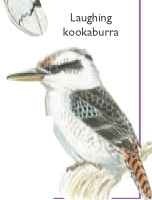
| vital statistics | |
| Weight | 11-17 oz. |
| Length | 16-18″ |
| Wingspan | 20-24″ |
| Sexual Maturity | 1 year |
| Breeding Season | September-December |
| Number of Eggs | 2 or 3 |
| Incubation Period | 24-26 days |
| Fledging Period | 33-39 days |
| Breeding Interval | i1 year |
| Typical | Rodents, frogs, lizards, snakes, insects, earthworms, crayfish,- nestling birds |
| Lifespan | 6-10 years |
Related species
• The kingfisher family Alcedinidae belongs to the order Coraciiformes, which includes bee-eater, roller and hornbill families. Alcedinidae has 87 species of kingfisher; 22 species feed exclusively on fish. Four nonfishing species are in the laughing kookaburra’s genus Dacelo: large laughing and blue-winged kookaburras and small rufous-bellied and spangled kookaburras.
